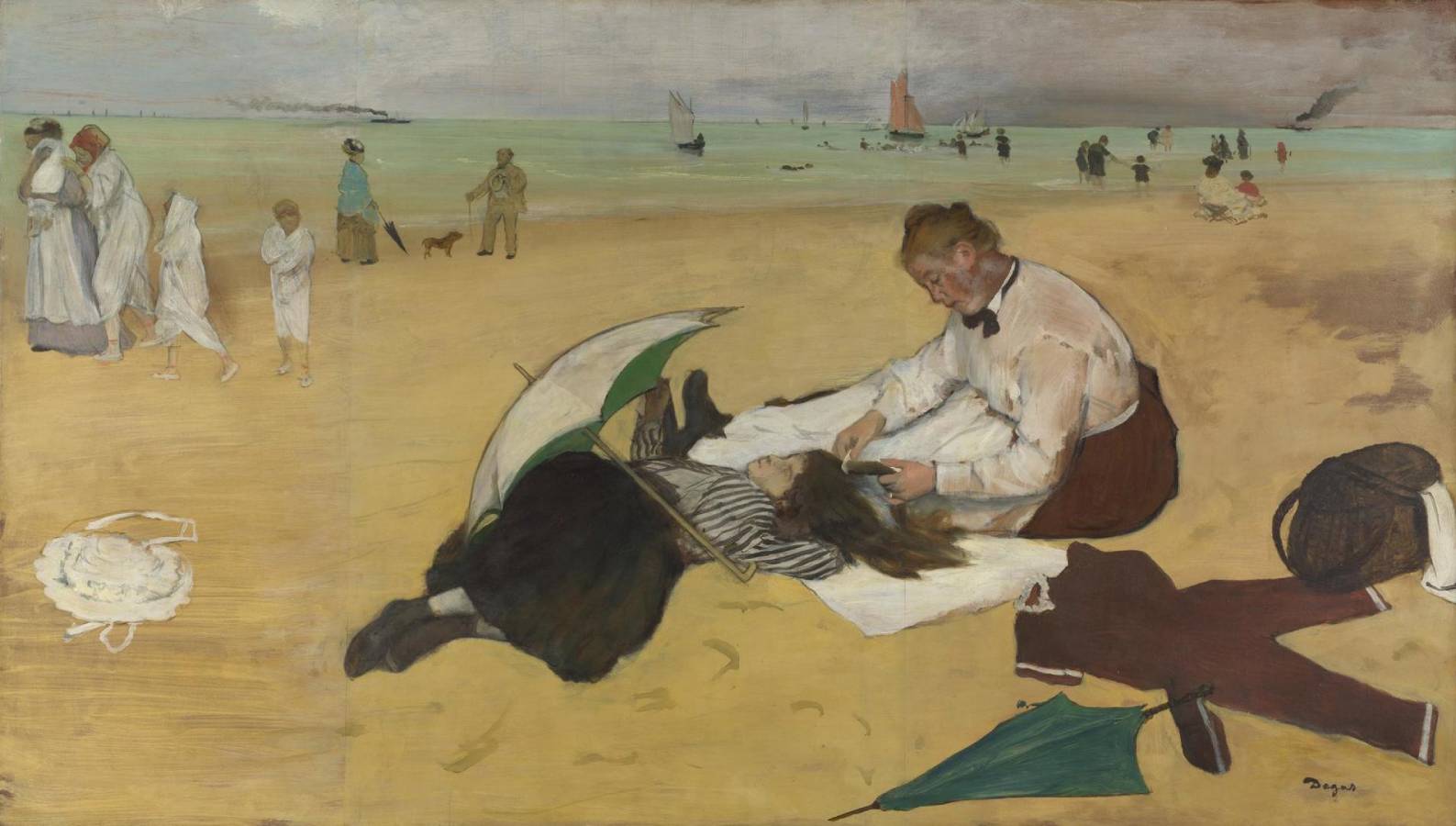Degas, Edgar (1834-1917)
Scène de plage (Beach Scene)
c.1869–1870
Oil (essence) on paper on canvas, 47.5 × 82.9 cm
National Gallery, London
A maid combs the hair of a girl who has been swimming; her bathing suit is stretched out on the ground to dry. Other objects – two parasols, a basket and a summer bonnet – are scattered around them. In the background, a family group – some members wrapped in towels – is leaving the shoreline, as other people stroll on the beach.
The picture was painted with essence – oil paint from which most of the oil has been removed with blotting paper, which is diluted with turpentine to give the effect of watercolour. It is one of four paintings of beach scenes that Degas completed in around 1869. That year he travelled to the northern French coast and made a series of landscapes in pastel. While some of the pastels may have been completed on site, Degas later stated that this picture had been finished in the studio, commenting, ‘the air you breathe in a picture is not necessarily the same as the air you breathe out of doors’. All four beach paintings include young women beside the sea, bathing, attending to their hair or resting.
Small paintings of beach and seaside scenes in resorts such as Trouville were popular with several of Degas’s contemporaries, including Whistler, Boudin and Monet. An immediate precedent was Manet’s Beach at Boulogne (Museum of Fine Arts, Richmond Virginia), from which Degas borrowed various elements. The two artists had a friendly but competitive relationship, and may well have travelled together to the channel coast in 1869. Both paintings have three horizontal bands for the sandy beach, turquoise-green sea and grey sky. Both also have sailboats in the distance – curiously, smoke from the two steamboats in Degas’s picture blows in opposite directions – and a scattering of bathers and walkers on the beach. Degas had originally planned to include a bathing machine, as Manet had, but he later removed it. Manet’s figures are of more or less of equal size, but Degas gives much greater emphasis to the girl and her maid.
Degas may have decided to paint beach scenes partly for commercial reasons, as marine subjects were popular with art buyers, particularly in England. He was familiar with British maritime pictures, but his painting is also profoundly influenced by Japanese woodblock prints. He especially admired the work of Ando Hiroshige (1797–1858), and owned over 40 of his landscapes. Hiroshige specialised in spacious panoramas which often contained little more than waves, rocks and sail boats in the distance to emphasise the contrast between the vast ocean and the deserted shore. Degas adopted the distinct spatial composition of Japanese prints, and several of their recurrent motifs, including a woman combing her hair or having it combed, also became part of his own repertoire.
Japanese prints were often made as triptychs, and the fact that this picture consists of three sheets of paper stuck together might seem to echo this construction. However, the addition of sheets either side of the central section containing the girl was most likely due to Degas’s decision to expand and modify the composition. The painting was owned by Henri Rouart, the father of Hélène Rouart, whose portrait was painted by Degas. The beach scene was exhibited at the Third Impressionist Exhibition in 1877. (NG)
Compare:
 Manet, Édouard (1832-1883)
Manet, Édouard (1832-1883)
Sur la plage de Boulogne
1868
Virginia Museum of Fine Arts, Richmond
